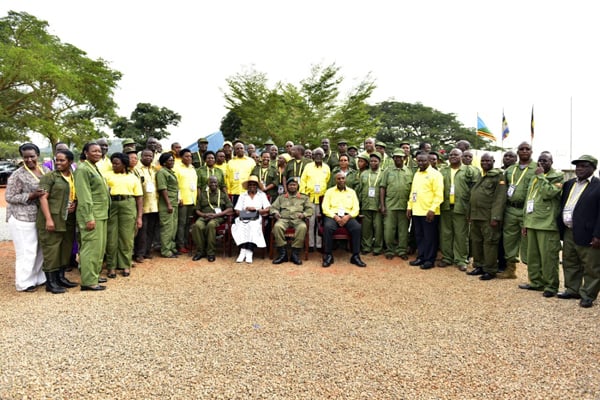Prime
Who’s left of Museveni’s first Cabinet 36 years later?

President Museveni (seated, centre) with members of his 2016 Cabinet during a retreat in Kyankwanzi, in 2019. PHOTO/FILE
What you need to know:
- Only two of the members of the 29-member 1986 Cabinet remain on the current list, while 16 of them are long gone, writes Isaac Mufumba.
When President Museveni announced a new Cabinet in June 2016, he kept four people from the 1986 cabinet: Dr Ruhakana Rugunda, who was named prime minister; Gen Moses Ali, who was named first deputy prime minister; Mr Kirunda Kivejinja, who was named second deputy prime minister; and Maj Gen Kahinda Otafiire, who was named minister for Justice and Constitutional Affairs.
The headcount from Mr Museveni’s Cabinet when he first took power in January 1986 has continued to diminish over the years. Sixteen out of the 29 people who were part of that first Cabinet in 1986 are long gone.
Another big number of that Cabinet are living in quiet retirement and out of the limelight.
The death of Kivejinja in December 2020, and the subsequent decision to drop Dr Rugunda, who was last year replaced by Ms Robinah Nabbanja as prime minister, means only two of the 1986 lot remain in Cabinet. These are Gen Ali, whose first docket was the Ministry of Tourism and Wildlife, and Maj Gen Otafiire, who was first named deputy minister for Local Government.
But whereas the two are the only survivors in Cabinet from 1986, their stay in government has not been without interruptions.
Maj Gen Otafiire
In October 1988, Maj Gen Otafiire was involved in a public altercation with Ms Jennifer Kuteesa and he drew a gun. Mr Otafiire was the following month forced to tender his resignation.
The State-owned Radio Uganda broadcast a statement in which Mr Museveni said he had accepted the resignation “because the National Resistance Movement (NRM) government will not tolerate any indiscipline displayed by anybody regardless of his position”.
Gen Otafiire bounced back when he was named minister of State for Local Government in the Cabinet that was formed after the 1996 elections, but the Ruhinda County MP was dropped when Mr Museveni shuffled his Cabinet in April 1999.
Gen Otafiire did not take news of his being dropped very lightly and went public about it.
“Having worked with the President for the last 27 years, I felt a chord of comradeship had developed between us. I am very unhappy that he announced my sacking in such a manner. When one is appointed, he is told, and that’s how it should be when he is sacked,” Gen Otafiire told the State-owned The New Vision.
About a week later, Gen Otafiire, who was still angry for being dropped over the radio, gave another interview to The New Vision, in which he reminded the public that he had the capacity to rock the boat.
“I would want to know why he dropped me. I will ask him what happened because I just do not know what is going on. I have the capacity to cause trouble because I am a soldier,” he said.
The commotion that his remarks caused was snuffed out when Mr Museveni, while addressing an NRM retreat at the YMCA conference centre in Jinja, declared that Gen Otafiire actually had no capacity to cause trouble.
Gen Otafiire was then a military advisor on Democratic Republic of Congo affairs when Uganda and Rwanda made incursions into the mineral-rich country.
He, however, bounced back into government when a new Cabinet was formed after the 2001 General Election.
It is worth noting though, that Gen Otafiire is also one of the longest serving NRM legislators. Despite the fact that his tenure in Parliament was interrupted in 2016 when he suffered reversals in the 2015 NRM primaries and the general election that followed at the hands of Capt Donozio Kahonda, his re-election in last year’s parliamentary elections means he will have served as a directly elected MP for two decades when the life of the 11th Parliament draws to an end.

President Yoweri Museveni. Photo | File
Gen Moses Ali
In April 1990, Gen Ali, who was the minister for Youth, Culture and Sports, was charged with treason after he was accused of being in possession of arms and ammunition illegally. He was incarcerated in Luzira prison, but released in 1992.
In February 2006, he surprisingly lost his parliamentary seat to Mr Santos Eruaga Mulago, bringing an end to his more than 16 years’ tenure as the area MP.
He had become a member of the National Resistance Council (NRC) in the 1980s after his Uganda National Rescue Front (UNRF) sealed a deal with the National Resistance Army (NRA) and it was integrated into the NRA.
He, however, recaptured his seat in the 2011 elections. He retained it in 2016 and 2021, which has now put him in position to become the second longest serving legislator after Kamuli Woman MP Rebecca Kadaga.
Gen Ali will by the end of the life of the 11th Parliament have made 31 years as an MP.
The departed
The dead include Dr Samson Kisekka, who was Uganda’s first prime minister of the NRM regime before he was elevated on January 22, 1991, to become Mr Museveni’s first vice president.
Dr Kisekka passed away on October 25, 1999, at the University College Hospital in London, Britain.
At the time of his death, Dr Kisekka had in 1994 been dropped and replaced as vice president by Dr Speciosa Wandira Kazibwe. The late Kisekka had been appointed a presidential advisor.
Others from the 1986 Cabinet, who are deceased include Dr Ponsiano Mulema, who was the minister of Finance; Robert Kitariko, who was the minister of Agriculture; Sam Njuba, who was the minister of Constitutional Affairs; Abubaker Kakyama Mayanja, who was the minister of Information, Evaristo Nyanzi, who was named minister for Commerce and; Andrew Lutakome Kayira, who was first named minister for Energy.
Kayira was gunned down on March 6, 1987 in the home of BBC stringer, Mr Henry Gombya, in Lukuli-Konge Village, Kampala.
The others who are departed are Joseph Mulenga, who was the minister for Justice; Chango Macho W’Obanda, who was the minister for Minerals and Water Development; Jehoash Mayanja Nkangi, who was the minister for Education; James Wapakhabulo, who was the minister for Housing and Urban Development; John Ssebaana Kizito, who was the minister for Regional Cooperation; and Prof Yoweri Kyesimira, who was the minister for Planning and Economic Development.
Also deceased is Stanislaus Okurut, who was the minister for Transport and Communication; Kirunda Kivejinja, who was in-charge of Relief and Social Rehabilitation.
Dr Mulema, Kitariko, Kakyama Mayanja, Nyanzi, Ssebaana Kizito, Kyesimira were drawn from the Democratic Party (DP); Stanislas Okurut from the Uganda People’s Congress (UPC); Kayiira from the Uganda Freedom Movement (UFM) and Jehoash Mayanja Nkangi from the Conservative Party (CP) as the NRM formed what came to be known as a broad-based government.
Deceased deputy ministers
Also among the dead, are two of the people who were named deputy ministers. These were John Ntimba, who was deputy minister in-charge of Higher Education, and Mawumbe Mukwana, who was deputy minister for Information and Broadcasting.
Whereas the likes of Evaristo Nyanzi and Dr David Livingstone Lwanga were some of the first people to be dropped following their arrest on charges of treason, some members of the 1986 team who fell out with Mr Museveni have since challenged him for the job.
Kawanga Ssemogerere resigned his job as deputy prime minister and Minister of Public Service. That set the ground for him to contest in the 1996 elections as a candidate of the multi-partyists.
Other members of that Cabinet, Col Dr Kizza Besigye and Ssebaana Kizito, also challenged him for the job in 2001 and 2006 before Mr Jaberi Bidandi Ssali joined the fray in 2011.
Dr Besigye contested in the 2001, 2006, 2011 and 2016 elections and remains heavily involved in political activism.




